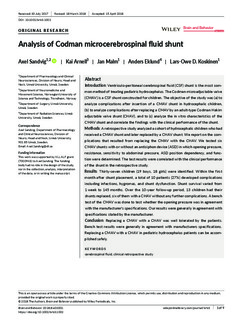| dc.contributor.author | Sandvig, Axel | |
| dc.contributor.author | Arnell, Kai | |
| dc.contributor.author | Malm, Jan | |
| dc.contributor.author | Eklund, Anders | |
| dc.contributor.author | Koskinen, Lars-Owe | |
| dc.date.accessioned | 2019-09-02T13:38:42Z | |
| dc.date.available | 2019-09-02T13:38:42Z | |
| dc.date.created | 2018-10-25T14:51:01Z | |
| dc.date.issued | 2018 | |
| dc.identifier.citation | Brain and Behavior. 2018, 8 (10), 1-9. | nb_NO |
| dc.identifier.issn | 2162-3279 | |
| dc.identifier.uri | http://hdl.handle.net/11250/2612079 | |
| dc.description.abstract | Introduction
Ventriculo‐peritoneal cerebrospinal fluid (CSF) shunt is the most common method of treating pediatric hydrocephalus. The Codman microadjustable valve (CMAV) is a CSF shunt constructed for children. The objective of the study was (a) to analyze complications after insertion of a CMAV shunt in hydrocephalic children, (b) to analyze complications after replacing a CMAV by an adult‐type Codman Hakim adjustable valve shunt (CHAV), and to (c) analyze the in vitro characteristics of the CMAV shunt and correlate the findings with the clinical performance of the shunt.
Methods
A retrospective study analyzed a cohort of hydrocephalic children who had received a CMAV shunt and later replaced by a CHAV shunt. We report on the complications that resulted from replacing the CMAV with the CHAV. We tested six CMAV shunts with or without an antisiphon device (ASD) in which opening pressure, resistance, sensitivity to abdominal pressure, ASD position dependency, and function were determined. The test results were correlated with the clinical performance of the shunt in the retrospective study.
Results
Thirty‐seven children (19 boys, 18 girls) were identified. Within the first month after shunt placement, a total of 10 patients (27%) developed complications including infections, hygromas, and shunt dysfunction. Shunt survival varied from 1 week to 145 months. Over the 10‐year follow‐up period, 13 children had their shunts replaced, six of them with a CHAV without any further complications. A bench test of the CMAV was done to test whether the opening pressure was in agreement with the manufacturer's specifications. Our results were generally in agreement with specifications stated by the manufacturer.
Conclusion
Replacing a CMAV with a CHAV was well tolerated by the patients. Bench test results were generally in agreement with manufacturers specifications. Replacing a CMAV with a CHAV in pediatric hydrocephalus patients can be accomplished safely. | nb_NO |
| dc.language.iso | eng | nb_NO |
| dc.publisher | Wiley | nb_NO |
| dc.rights | Navngivelse 4.0 Internasjonal | * |
| dc.rights.uri | http://creativecommons.org/licenses/by/4.0/deed.no | * |
| dc.title | Analysis of Codman microcerebrospinal fluid shunt | nb_NO |
| dc.type | Journal article | nb_NO |
| dc.type | Peer reviewed | nb_NO |
| dc.description.version | publishedVersion | nb_NO |
| dc.source.pagenumber | 1-9 | nb_NO |
| dc.source.volume | 8 | nb_NO |
| dc.source.journal | Brain and Behavior | nb_NO |
| dc.source.issue | 10 | nb_NO |
| dc.identifier.doi | 10.1002/brb3.1002 | |
| dc.identifier.cristin | 1623567 | |
| dc.description.localcode | © 2018 The Authors. Brain and Behavior published by Wiley Periodicals, Inc. This is an open access article under the terms of the Creative Commons Attribution License, which permits use, distribution and reproduction in any medium, provided the original work is properly cited. | nb_NO |
| cristin.unitcode | 194,65,30,0 | |
| cristin.unitname | Institutt for nevromedisin og bevegelsesvitenskap | |
| cristin.ispublished | true | |
| cristin.fulltext | original | |
| cristin.qualitycode | 1 | |

